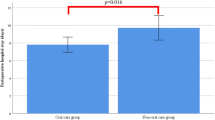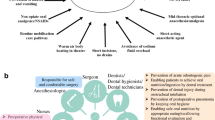Abstract
Objectives
Perioperative oral care was reported to decrease postoperative pneumonia after cancer resections. However, the effect remains controversial because previous studies were limited due to their small sample sizes and lack of strict control for patient backgrounds. The present study evaluated the association between perioperative oral care and postoperative pneumonia using high-dimensional propensity score (hd-PS) matching to adjust for confounding factors.
Materials and methods
Using a Japanese health insurance claims database, we identified patients who underwent surgical treatment of cancer from April 2014 to March 2015. To compare outcomes (postoperative pneumonia and procedure-related complications) between patients with and without perioperative oral care, we performed hd-PS matching and conventional PS matching and chi-square test.
Results
We identified 621 patients with oral care and 4374 patients without oral care. The occurrences of postoperative pneumonia were not significantly different between patients with and without oral care in the unmatched (2.9% vs. 3.2%), conventional PS-matched (2.9% vs. 2.9%), or hd-PS-matched (2.9% vs. 3.3%) groups. The occurrences of procedure-related complication were not significantly different between patients with and without oral care in the unmatched (23.8% vs. 24.5%), conventional PS-matched (23.8% vs. 26.4%), or hd-PS-matched (24.4% vs. 27.7%) groups.
Conclusions
There was no significant difference in postoperative pneumonia or procedure-related complications between patients with and without perioperative oral care.
Clinical relevance
While maintaining optimal oral care in cancer patients is an important goal, the present study revealed no significant difference in postoperative outcomes. Further investigations would be needed to determine the effect of perioperative oral care.

Similar content being viewed by others
References
Spreadborough P, Lort S, Pasquali S et al (2016) A systematic review and meta-analysis of perioperative oral decontamination in patients undergoing major elective surgery. Perioper Med 5:6–12
Zuckerman LM (2016) Oral chlorhexidine use to prevent ventilator-associated pneumonia in adult. Dimens Crit Care Nurs 35(1):25–36
Silvestri L, Weir I, Gregori D et al (2014) Effectiveness of oral chlorhexidine on nosocomial pneumonia, causative micro-organisms and mortality in critically ill patients: a systematic review and meta-analysis. Minerva Anestesiol 80(7):805–820
Vilela MC, Ferreira GZ, Santos PS, Rezende NP (2015) Oral care and nosocomial pneumonia: a systematic review. Einstein 13(2):290–296
Ono S, Ishimaru M, Yamana H et al (2017) Enhanced oral care and health outcomes among nursing facility residents: analysis using the national long-term care database in Japan. J Am Med Dir Assoc 18(3):e1–e5
Sjögren P, Wårdh I, Zimmerman M, Almståhl A, Wikström M (2016) Oral care and mortality in older adults with pneumonia in hospitals or nursing homes: systematic review and meta-analysis. J Am Geriatr Soc 64(10):2109–2115
Kaneoka A, Pisegna JM, Miloro KV, Lo M, Saito H, Riquelme LF, LaValley MP, Langmore SE (2015) Prevention of healthcare-associated pneumonia with oral care in individuals without mechanical ventilation: a systematic review and meta-analysis of randomized controlled trials. Infect Control Hosp Epidemiol 36(8):899–906
Tohara T, Kikutani T, Tamura F, Yoshida M, Kuboki T (2017) Multicentered epidemiological study of factors associated with total bacterial count in the saliva of older people requiring nursing home. Geriatr Gerontol Int 17(2):219–225
Ishikawa A, Yoneyama T, Hirota K, Miyake Y, Miyatake K (2008) Professional oral health care reduces the number of oropharyngeal bacteria. J Dent Res 87:594–598
El-Solh AA, Pietrantoni C, Bhat A et al (2004) Colonization of dental plaques: a reservoir of respiratory pathogens for hospital acquired pneumonia in institutionalized elders. Chest 126:1575–1582
Bágyi K, Haczku A, Márton I, Szabó J, Gáspár A, Andrási M, Varga I, Tóth J, Klekner A (2009) Role of pathogenic oral flora in postoperative pneumonia following brain surgery. BMC Infect Dis 9:104–113
Wren SM, Martin M, Yoon JK, Bech F (2010) Postoperative pneumonia-prevention program for the inpatient surgical ward. J Am Coll Surg 210:491–495
Akutu Y, Matsubara H, Okazumi S et al (2008) Impact of preoperative dental plaque culture for predicting postoperative pneumonia in esophageal cancer patients. Dig Surg 25:93–97
Akutsu Y, Matsubara H, Shuto K, Shiratori T, Uesato M, Miyazawa Y, Hoshino I, Murakami K, Usui A, Kano M, Miyauchi H (2010) Pre-operative dental brushing can reduce the risk of postoperative pneumonia in esophageal cancer patients. Surgery 147:497–502
Yamazaki M, Matsuura K, Kato K et al (2009) Perioperative oral care reduced postoperative complications after head and neck reconstruction surgery. Tokeibu Geka 19:105–110 (Japanese)
Hoshikawa Y, Tanda N, Matsuda Y et al (2016) Current status of preoperative professional oral care by dentists for elderly patients undergoing lung resection and occurrence of postoperative pneumonia. Kyobu Geka 69(1):25–29 (Japanese)
Soutome S, Yanamoto S, Funahara M, Hasegawa T, Komori T, Oho T, Umeda M (2016) Preventive effect on post-operative pneumonia of oral health care among patients who undergo esophageal resection: a multi-center retrospective study. Surg Infect 17(4):479–484 (Japanese)
Atkinsm BZ, Shah AS, Hutcheson KA et al (2004) Reducing hospital morbidity and mortality following esophagectomy. Ann Thorac Surg 78:1170–1176
Fang W, Kato H, Tachimori Y, Igaki H, Sato H, Daiko H (2003) Analysis of pulmonary complications after three-field lymph node dissection for esophageal cancer. Ann Thorac Surg 76:903–908
Trinh VQ, Ravi P, Abd-El-Barr AM et al (2016) Pneumonia after major cancer surgery: temporal trends and patterns of care. Can Respir J 2016:1–7
Sato J, Goto J, Harahashi A, Murata T, Hata H, Yamazaki Y, Satoh A, Notani KI, Kitagawa Y (2011) Oral health care reduced the risk of postoperative surgical site infection in inpatients with oral squamous cell carcinoma. Support Care Cancer 19:409–416
Ueno T, Ota Y (2012) The importance of perioperative oral care. Jpn J Anesthesiol (Masui) 61(3):276–281 (Japanese)
Kimura S, Sato T, Ikeda S, Noda M, Nakayama T (2010) Development of a database of health insurance claims: standardization of disease classifications and anonymous record linkage. J Epidemiol 20:413–419
Ono S, Ono Y, Matsui H, Yasunaga H (2016) Factors associated with hospitalization for seasonal influenza in a Japanese nonelderly cohort. BMC Public Health 16:922–929
Garbe E, Kloss S, Suling M, Pigeot I, Schneeweiss S (2013) High-dimensional versus conventional propensity scores in a comparative effectiveness study of coxibs and reduced upper gastrointestinal complications. Eur J Clin Pharmacol 69:549–557
Schneeweiss S, Rassem JA, Glynn RJ et al (2009) High-dimensional propensity score adjustment in studies of treatment effects using health care claims data. Epidemiology 20:512–522
Toh S, Rodríguez LAG, Hernán MA (2011) Confounding adjustment via a semi-automated high-dimensional propensity score algorithm: an application to electronic medical records. Pharmacoepidemiol Drug Saf 20:849–857
Franklin JM, Eddings W, Glynn RJ, Schneeweiss S (2015) Regularized regression versus the high-dimensional propensity score for confounding adjustment in secondary database analyses. Am J Epidemiol 182:651–659
Bross ID (1966) Spurious effects from an extraneous variable. J Chronic Dis 19:637–647
Soutome S, Yanamoto S, Funahara M, Hasegawa T, Komori T, Yamada SI, Kurita H, Yamauchi C, Shibuya Y, Kojima Y, Nakahara H, Oho T, Umeda M (2017) Effect of perioperative oral care on prevention of postoperative pneumonia associated with esophageal cancer surgery: a multicenter case-control study with propensity score matching analysis. Medicine (Baltimore) 96(33):e7436–e7440
Yang CK, Teng A, Lee DY, Rose K (2015) Pulmonary complications after major abdominal surgery: National Surgical Quality Improvement Program analysis. J Surg Res 198(2):441–449
Kiuchi J, Komatsu S, Ichikawa D, Kosuga T, Okamoto K, Konishi H, Shiozaki A, Fujiwara H, Yasuda T, Otsuji E (2016) Putative risk factors for postoperative pneumonia which affects poor prognosis in patients with gastric cancer. Int J Clin Oncol 21:920–926
Pettke E, Ilonzo N, Ayewah M, Tsantes S, Estabrook A, Ma AM (2016) Short-term, postoperative breast cancer outcomes in patients with advanced age. Am J Surg 212(4):677–681
Hall MK, Taylor RA, Luty S, Allen IE, Moore CL (2016) Impact of point-of-care ultrasonography on ED time to disposition for patients with nontraumatic shock. Am J Emerg Med 34:1022–1030
Rassen JA, Schneeweiss S (2012) Using high-dimensional propensity scores to automate confounding control in a distributed medical product safety surveillance system. Pharmacoepidemiol Drug Saf 21:41–49
Guertin JR, Rahme E, LeLorier J (2016) Performance of the high-dimensional propensity score in adjusting for unmeasured confounders. Eur J Clin Pharmacol 72(12):1497–1505
Guertin JR, Rahme E, Dormuth CR, LeLorier J (2016) Head to head comparison of the propensity score and the high-dimensional propensity score matching methods. BMC Med Res Methodol 16:22–31
Chien SC, Ou SM, Shih CJ et al (2015) Comparative effectiveness of angiotensin-converting enzyme inhibitor and angiotensin II receptor blockers in terms of major cardiovascular disease outcomes in elderly patients. Medicine 94:1–10
Le HV, Poole C, Brookhart MA et al (2013) Effects of aggregation of drug and diagnostic codes on the performance of the high-dimensional propensity score algorithm: an empirical example. BMC Med Res Methodol 13:142–152
Hernandez I, Zhang Y (2015) Comparing clinical and economic outcomes of biologic and conventional medications in postmenopausal women with osteoporosis. J Eval Clin Pract 21:840–847
Yamana H, Moriwaki M, Horiguchi H et al (2017) Validity of diagnoses, procedures, and laboratory data in Japanese administrative data. J Epidemiol 1–7
Funding
This work was supported by grants from the Ministry of Health, Labour and Welfare, Japan (H29-Policy-Designated-009 and H29-ICT-General-004); Ministry of Education, Culture, Sports, Science, and Technology, Japan (17H04141); and the Japan Agency for Medical Research and Development (AMED).
Author information
Authors and Affiliations
Corresponding author
Ethics declarations
Conflict of interest
The authors declare that they have no conflict of interest.
Ethical approval
The Institutional Review Board at The University of Tokyo approved the study protocol.
Informed consent
Informed consent was waived because of the anonymous nature of the data.
Additional information
Publisher’s Note
Springer Nature remains neutral with regard to jurisdictional claims in published maps and institutional affiliations.
Rights and permissions
About this article
Cite this article
Ishimaru, M., Ono, S., Matsui, H. et al. Association between perioperative oral care and postoperative pneumonia after cancer resection: conventional versus high-dimensional propensity score matching analysis. Clin Oral Invest 23, 3581–3588 (2019). https://doi.org/10.1007/s00784-018-2783-5
Received:
Accepted:
Published:
Issue Date:
DOI: https://doi.org/10.1007/s00784-018-2783-5




